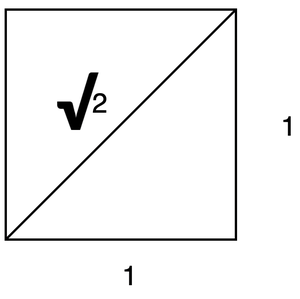我们通常研究并且到目前为止一直关注的数字是用于计数的正整数1,2,3,依此类推。这些被称为自然数,已经存在了数千年。
著名的数学家克罗内克(Kronecker)曾说过:
“God created the natural numbers; all the rest is the work of man.”
然后,生活的基本必需品导致了诸如3 / 4、1 / 5等分数的产生。这些数字称为有理数。
Note: These numbers are not called rational numbers because they are “reasonable”, they are called rational because they are ratios of whole numbers.
所有这些数字都可以表示在数字行中的特定位置。
但是大约2500年前,希腊人在研究几何学时发现了其他东西。他们惊讶地发现有些数字无法表示为比率整数。
例如:

他们注意到,边长单位为1的平方。对角线的长度不能用任何比例的整数表示。
用现代数学术语来说,这样的数字称为无理数。从几何学上讲,这意味着不存在公共单位(但是可能很小),因此正方形的边和对角线是其整数倍。类似地,圆的周长是直径的无理倍数。该倍数是“ pi”。
现在让我们正式定义有理数和无理数。
有理数
如果数字“ x”可以以“ p / q”的形式书写,则其中p和q是整数(q≠0),则它是有理数。
示例:25是有理数。如何? 25可以写成![]() 其中p = 25且q =1。类似地,5.5也是有理数,可以表示为
其中p = 25且q =1。类似地,5.5也是有理数,可以表示为![]() 等等。
等等。
无理数
如果不能以“ p / q”的形式写入数字“ x”,则称其为“无理数”,其中p和q为整数(q≠0)。就像有无限多个有理数一样,也有无限多个无理数。
例如: √2,√3, ![]()
√2= 1.41421356237309504880…
![]() = 3.14159265358979323846264338327950…
= 3.14159265358979323846264338327950…
识别不合理数字的另一个提示是小数继续而不重复。
热门非理性数字:
- Pi , π = 3.14159265358979323846264338327950…。这是一个非常有名的非理性数字。人们已经计算出其值,直到小数点后四舍五入,但仍未找到任何模式。
- 欧拉数“ e” 。它在数学中也很受欢迎。同样,在这种情况下,人们尝试计算最多十进制数,但仍未找到任何模式。 e = 2.7182818284590452353602874713527(以及更多…)。
- 黄金比例。这是在计算机科学,设计,艺术,建筑等许多领域中发现的非理性数字。
√2是无理数吗?
Proof:
To begin with, let’s suppose it is a Rational Number
Since it is Rational, It can be represented in the most simplified form P/Q where P/Q are Integers (Q≠ 0) and P/Q can not be further simplified,
Which means that the fraction P/Q is irreducible.
P/Q = √2
Squaring both Sides:
(P/Q)2 = 2
P2/Q2 = 2
P2 = 2 Q2
Here, It is clear that P2 is divisible by 2. Therefore, P2 is an Even Number.
Since, P2 is Even, P has to be an Even number too.
Therefore, P can be written as 2A as it is divisible by 2.
By putting the value P = 2A, we will get:
(2A)2 = 2Q2
4A2 = 2Q2
2A2 = Q2
Here, It is observed that Q2 is also an Even number as it is divisible by 2.
Since Q2 is Even, Q has to be Even too. Therefore, Both P and Q turned out to be Even numbers, which means they can be Simplified further.
It is a Contradiction as it was already defined to be a fraction in its simplest form.
Therefore, √2 cannot be Rational, It is an Irrational number.
无理数的性质
无理数和有理数的加法:
The addition of an irrational and a rational number always gives an irrational number.
For example, it’s known that √2 = 1.41421356237309504880… Now √2 + 1 = 2.41421356237309504880…. This is still irrational.
无理数与非零有理数的乘积。
Multiplication of any irrational number with any nonzero rational number results in an irrational number.
Proof: Let x be an irrational number and y be a non-zero rational number.
We want to know if z = xy is irrational or rational ?
This will be proved by contradiction. Let’s assume z is rational number.
If z is rational, then x = z/y where both z and y are rational number. This makes x as rational number. This is a contradiction, which means that the previous assumption was wrong. So, z will always be irrational number.
两个无理数的乘积:
When multiplying a rational number, it is not necessary that the resulting number is always irrational.
- π × π = π2 is irrational.
- But √2 × √2 = 2 is rational.
两个无理数之和:
The answer to this is also similar to the above property. The Sum of two irrational numbers is sometimes rational sometimes irrational.
- 3√2 + 4√3 is irrational.
- (3√2 + 6) + (- 3√2) = 6, this is rational.
Fun Fact: Apparently Hippasus (one of Pythagoras’ students) discovered irrational numbers when trying to write the square root of 2 as a fraction (using geometry, it is thought). Instead, he proved the square root of 2 could not be written as a fraction, so it is irrational.
But followers of Pythagoras could not accept the existence of irrational numbers, and it is said that Hippasus was drowned at sea as a punishment from the gods!
Pi之谜
让我们围成一个圆圈,测量其周长,然后将其除以直径。如果精确测量,它将始终是一个常数。
这个恒定比率用希腊符号表示![]() (读为pi)。那是,
(读为pi)。那是,
![]()
它是一个重要的普遍常数,它存在于我们宇宙和日常生活的许多地方。它不是人类创造的,而是被发现的。我们发现发生pi的地方之一是几何。
那么, Pi的价值是什么?
π= 3.14159265358979323846264338327950…
它不是无限的,它是一个无理数。
Note: We often take ![]() as value of Pi, but it is an approximation.
as value of Pi, but it is an approximation.
现在人们可能会认为,理性是非理性的吗?一个可以测量周长,一个可以测量直径,然后取它们的比率。因此它必须是理性的。
实际上,如果对直径进行测量并且是合理的,那么任何人都不会遇到这种情况。那么圆周必须是非理性的,反之亦然。因此,无论是直径还是周长。其中之一永远是不理性的。通常,测量仪器不够精确。如果存在一个完美的量表,它将表明该分数中的至少一个数字是不合理的。
关于无理数的一些样本问题
问题1:这些数字是否属于非理性数字类别:5、3.45、4.444444…,√9。
回答:
These numbers mentioned above are not Irrational number.
- 5 is a Whole number and therefore, is Rational
- 3.45 is a number with Terminating Decimal and therefore, it is Rational too.
- 4.444444… is a Number with Repeating Decimal Expansion, It is Rational.
- √9 is 3 i.e; the square root of 9 is 3 and 3 is a Whole number. Therefore, √9 is Rational.
问题2: “每个实数都是一个无理数”。对或错?
答:
False, All numbers are real numbers and all non-terminating real numbers are irrational number. For example 2, 3, 4, etc. are some example of real numbers and these are not irrational.
问题3:确定以下数字是有理数还是无理数。
√3,74,8.432432432 …,3.14159265358979 …,√11,55/5。
答:
74, 8.432432432…, and 55/5(11) are Rational numbers as either they are Integers or their decimal expansions are terminating, repeating.
√3, 3.14159265358979…, and √11 are Irrational numbers as their decimal Expansions are Non-terminating, Non-repeating.
问题4 :为什么整数不是无理数?
答:
Integers (Either Positive, Negative or Zero) are not Irrational but Rational numbers since they can be represented in the simplest fraction form P/Q (where Q ≠ 0).